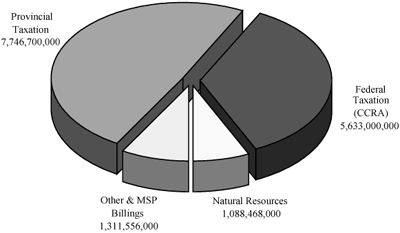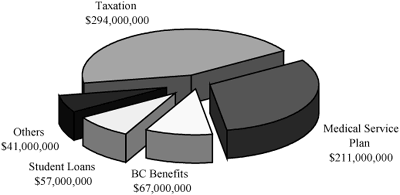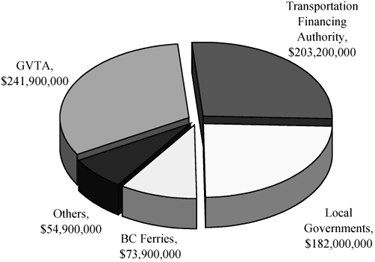 |
|
Strategic ContextMinistry Overview:The Ministry of Provincial Revenue provides a central service to the Province of British Columbia for revenue and debt administration and collection — including income, consumption, resource and property taxes — as well as Medical Services Plan premiums, certain fees and outstanding debts and receivables. The Ministry manages billings and receivables, tax appeals, and administers loans on behalf of the Province. Revenue SourcesTable 1 illustrates the total annual estimated revenues of the Ministry estimated at close to $16 billion for fiscal 2002/03. Table 1
Accounts ReceivableThe Ministry manages tax and non-tax accounts receivables portfolios totaling $670 million as at September 30, 2002 under the tax revenue and debt administration core business functions. The accounts receivables for debt administration consist of portfolios for which the Ministry provides a collection service on behalf of another Ministry. Table 2 shows the sources of accounts receivable revenue related to core business functions for tax revenue and debt administration. Table 2
Financing TransactionsTable 3 shows how the Ministry disperses some of the direct taxation revenue to other entities. The Ministry will disperse $755.9 million in fiscal 2002/03 from direct taxation to the Greater Vancouver Transportation Authority, Build BC, local governments, British Columbia Ferry Corporation, and others. Table 3
Strategic PlanOver the next three years, the Ministry of Provincial Revenue will be enhancing government revenue management practices to reduce outstanding amounts owed, including:
The strategic shifts are outlined in Table 4 below. Table 4 — Strategic Shifts in Revenue Management
This Service Plan sets out the expectations for the Ministry’s performance and establishes a framework for a clear assessment of the Ministry’s success in achieving its goals and objectives. The plan complies with the amended Budget Transparency and Accountability Act. The Act requires that every Ministry produce a three-year service plan which includes a statement of goals, strategic objectives and performance measures. In addition, Treasury Board requires that service plans contain three-year targets. This Service Plan does not present a work plan for individual program areas or a detailed account of the Ministry’s anticipated activities, programs or initiatives over the next three years. Information about the Ministry’s activities, together with reports on the outcomes of program and policy initiatives, is contained in the Annual Service Plan Report published by the Ministry after each fiscal year.
|
||||||||||||||||||||||||||||||
|
|||||||||||||||||||||||||||||||



